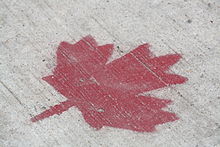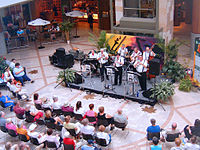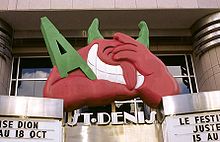- Culture of Canada
-
Culture of Canada
This article is part of a series History Canadians
Canadian identity
Canadian nationalism
Royal symbols
National symbols
Cultural protectionism
Multiculturalism in Canada
Ethnic origins
Immigration
Official bilingualism
Spoken languagesTopics Architecture · Bibliography
Art · Cinema
Cuisine · Festivals · Humour
Literature · Media · Music
Politics · Religion
Sports · Television · TheatrePortal Canadian culture is a term that explains the artistic, musical, literary, culinary, political and social elements that are representative of Canada and Canadians, not only to its own population, but people all over the world. Canada's culture has historically been influenced by European culture and traditions, especially British and French. Over time, elements of the cultures of Canada's Aboriginal peoples and immigrant populations have become incorporated into mainstream Canadian culture. It has subsequently been influenced by American culture because of its proximity and migration between the two countries.[1][2]
Canada's federal government has influenced Canadian culture with programs, laws and institutions. It has created crown corporations to promote Canadian culture through media, such as the Canadian Broadcasting Corporation (CBC) and the National Film Board of Canada (NFB), and promotes many events which it considers to promote Canadian traditions. It has also tried to protect Canadian culture by setting legal minimums on Canadian content in many media using bodies like the Canadian Radio-television and Telecommunications Commission (CRTC).[3]
Canada's culture, like that of most any country in the world, is a product of its history, geography, and political system. Being a settler nation, Canada has been shaped by waves of migration that have combined to form a unique blend of customs, cuisine, and traditions that have marked the socio-cultural development of the nation.[1] In this article, several aspects of Canadian culture will be discussed. Though this article attempts to feature a variety of subjects pertinent to the culture of Canada, it is in no way exhaustive, and to gain a much deeper knowledge of Canada and its culture, one must also consult the other articles pertaining to Canada and its peoples.
Contents
Development of Canadian culture
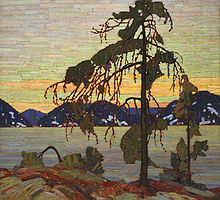 The Jack Pine, by Tom Thomson, 1916. Oil on Canvas, in the collection of the National Gallery of Canada
The Jack Pine, by Tom Thomson, 1916. Oil on Canvas, in the collection of the National Gallery of Canada See also: History of Canada
See also: History of CanadaCanadian culture is a product of Canada's history and geography. Most of Canada's territory was inhabited and developed later than other European colonies in the Americas, with the result that themes and symbols of pioneers, trappers, and traders were important in the early development of Canadian culture.[4] The British conquest of Canada in 1759 brought a large Francophone population under British rule, creating a need for compromise and accommodation, while the migration of 46,000United Empire Loyalists from the Thirteen Colonies brought American influences which gave the Canadian provinces a distinct American flavor until 1830. The refugees from the Colonies to the south were royalists, but most were also Americans, hence the closeness of the two cultures.
Although not without conflict, Canada's early interactions with First Nations and Inuit populations were relatively peaceful, compared to the experience of native peoples in the United States. Combined with relatively late economic development in many regions, this peaceful history has allowed Canadian native peoples to have a relatively strong influence on the national culture while preserving their own identity.[5]
Bilingualism and multiculturalism
Main articles: Official bilingualism in Canada, Spoken languages of Canada, Canadian English, and Quebec FrenchFrench Canada's early development was relatively cohesive during the 17th and 18th centuries, and this was preserved by the Quebec Act of 1774, which allowed Francophone culture to survive and thrive within Canada.[6] In 1867, the British North America Act was designed to meet the growing calls for Canadian autonomy while avoiding the overly-strong decentralization that contributed to the Civil War in the United States.[7] The compromises made by Macdonald and Cartier set Canada on a path to bilingualism,[8] and this in turn contributed to an acceptance of diversity that later led to both multiculturalism and tolerance of Native culture and customs.[9]
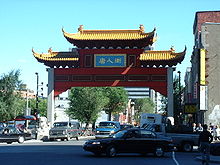 A Chinese gate in downtown Montreal.
A Chinese gate in downtown Montreal.
Multicultural heritage is enshrined in Section 27 of the Canadian Charter of Rights and Freedoms. In parts of Canada, especially the major cities of Montreal, Vancouver, and Toronto (for example, in Toronto's Kensington Market area), multiculturalism itself is the cultural norm and diversity is the force that unites the community.[10]
In Quebec, cultural identity is strong, and many French-speaking Quebecer commentators speak of a Quebec culture as distinguished from English Canadian culture, but some also see Canada as a collection of several regional, aboriginal, and ethnic subcultures.[11]
While French Canadian culture is the most obvious example, Celtic influences have allowed survival of non-English dialects in Nova Scotia and Newfoundland; however, the influence of Ulster immigrants to Toronto has had the effect of minimizing Irish influences in Ontario's culture, and highlighting British influences instead, until the 1980s. Canada's Pacific trade has also brought a large Chinese influence into British Columbia and other areas.
Canada's cultural diversity also creates an environment much more accepting of LGBT people than one finds in many other countries.[12] Canada has always placed emphasis on equality and inclusiveness for all people. For example, in 1995, the Supreme Court of Canada ruled in Egan v. Canada that sexual orientation should be "read in" to Section Fifteen of the Canadian Charter of Rights and Freedoms, a part of the Constitution of Canada guaranteeing equal rights to all Canadians. Following a series of decisions by provincial courts and the Supreme Court of Canada, on July 20, 2005, the Civil Marriage Act (Bill C-38) received Royal Assent, legalizing same-sex marriage in Canada. Canada thus became the fourth country to officially sanction same-sex marriage worldwide, after The Netherlands, Belgium, and Spain. Furthermore, by 2005, sexual orientation was included as a protected status in the human rights laws of the federal government and of all provinces and territories.
Further information: LGBT rights in CanadaAboriginal influences
Main articles: Aboriginal peoples in Canada#Culture and Inuit culture Many native icons, such as this dreamcatcher, have been adopted by Canadians as a whole.
Many native icons, such as this dreamcatcher, have been adopted by Canadians as a whole.
Aboriginal peoples in Canada interacted with Europeans as far back as 1000 AD,[13] but prolonged contact came only after Europeans established permanent settlements in the 17th and 18th centuries. European written accounts, though biased, generally noted friendliness on the part of the First Nations,[13] some of whom profited in trade with Europeans. Such trade generally strengthened the more organized political entities such as the Iroquois Confederation.[14]
There were, and are, many distinct Aboriginal peoples across Canada, each with its own culture, beliefs, values, language, and history. Much of this legacy remains celebrated artistically, and in other ways, in Canada to this day. Part of the emblem of the Vancouver 2010 Winter Olympics is an Inukshuk, a rock sculpture that is made by stacking stones in the shape of a human figure, that is a part of Inuit culture and the nation's perception of itself. According to the Department of Canadian Heritage.
Canada's ethnic, racial and religious diversity is rapidly increasing. According to the 2001 census, more than 200 ethnic origins are represented in Canada. About 13.5 percent of the population is a member of a visible minority group and that proportion is expected to reach 20 percent by 2016. Immigration now accounts for more than 50 percent of Canada's population growth, with immigrants coming mainly from Asia and the Middle East. It is projected that, after 2025, Canada's population growth will be based solely on immigration.—Judith Larocque, Deputy Minister, "Serving Canada's Multicultural Population: Practical Approaches for Public Servants."[15]Canadian identity
Main article: Canadian identityPrimary influences on the Canadian identity trace back to the arrival, beginning in the early 17th century, of French settlers to Acadia and Saint Lawrence River valley, English settlers to Newfoundland and the British conquest and settlement of New France from the early 18th century. First Nations played a critical part in the development of European colonies in Canada, from their role in assisting exploration of the continent, the fur trade and inter-European power struggles to the creation of the Métis people. Through their art and culture, First Nations, Inuit and Métis continue to exert influence on Canadian identity.
The question of Canadian identity was traditionally dominated by three fundamental themes: first, the often conflicted relations between English Canadians and French Canadians stemming from the French Canadian imperative for cultural and linguistic survival; secondly, the generally close ties between English Canadians and the British Empire, resulting in a gradual political process towards complete independence from the imperial power and, finally, the close proximity of English-speaking Canadians to the military, economic and cultural powerhouse of the United States. With the gradual loosening of political and cultural ties to the United Kingdom, in the 20th century immigrants from European, African, Caribbean and Asian nationalities have shaped the Canadian identity, a process that continues today with the continuing arrival of large numbers of immigrants from non British or French backgrounds, adding the theme of multiculturalism to the debate.[16][17][18] Today, Canada has a diverse makeup of nationalities and cultures and constitutional protection for policies that promote multiculturalism rather than a single national myth.[19]
The issue of Canadian identity remains under scrutiny, perhaps more than the identity of the people of any other modern nation.[20] Journalist Andrew Cohen wrote in 2007:
The Canadian Identity, as it has come to be known, is as elusive as the Sasquatch and Ogopogo. It has animated--and frustrated--generations of statesmen, historians, writers, artists, philosophers, and the National Film Board...Canada resists easy definition.—Andrew Cohen, The Unfinished Canadian: The People We Are[21]In true Canadian fashion, however, even the search for an identity has become itself an object for self-criticism.[22]
Canadian nationalism
Main article: Canadian nationalismIn general, Canadian nationalists are highly concerned about the protection of Canadian sovereignty and loyalty to the Canadian State, placing them in the civic nationalist category. It has likewise often been suggested that anti-Americanism, or at least hostility towards the United States, often plays a prominent role in Canadian nationalist ideologies. When nationalists speak of "independence", it is widely understood that the actual meaning is "independence from the United States".
Cultural protectionism in Canada
Main article: Canadian cultural protectionismCultural protectionism in Canada has, since the mid-20th century, taken the form of conscious, interventionist attempts on the part of various Canadian governments to promote Canadian cultural production and limit the effect of foreign, largely American, culture on the domestic audience. Sharing a large border and (for the majority) a common language with the United States, Canada faces a difficult position in regard to American culture, be it direct attempts at the Canadian market or the general diffusion of American culture in the globalized media arena. While Canada tries to maintain its cultural differences, it also must balance this with responsibility in trade arrangements such as the General Agreement on Tariffs and Trade (GATT) and the North American Free Trade Agreement (NAFTA).
 One of the national symbols of Canada, the beaver is depicted on the Canadian five-cent piece and was on the first Canadian postage stamp, c.1859.
One of the national symbols of Canada, the beaver is depicted on the Canadian five-cent piece and was on the first Canadian postage stamp, c.1859.
Symbols
Main articles: National symbols of Canada and Canadian royal symbolsOfficial symbols of Canada include the maple leaf, beaver, and the Canadian Horse.[23][24][25] Many official symbols of the country such as the Flag of Canada have been changed or modified over the past few decades in order to 'Canadianize' them and de-emphasise or remove references to the United Kingdom. Symbols of the monarchy in Canada continue to be featured in, for example, the Arms of Canada and armed forces Her Majesty's Canadian Ship. The designation 'Royal' remains for institutions as varied as the Royal Canadian Mounted Police and the Royal Winnipeg Ballet, though with the 1968 unification of the three armed forces into the Canadian Forces, the Royal Canadian Air Force and Royal Canadian Navy ceased to exist. However, certain Canadian Forces Land Force Command (army) units carry "Royal" titles, Canadian Forces Maritime Command vessels are still styled "HMCS" and Canadian Forces Air Command squadrons still use a Royal Air Force-derived badge surmounted by the Queen's Crown as their official crests. In 2011, the Canadian Forces commands reverted to their former names.
Arts
Main articles: Canadian art and List of Canadian artistsThe arts have flourished in Canada since the 20th century, and especially since the end of World War II in 1945. Government support has played a vital role in their development enabling visual exposure through publications and periodicals featuring Canadian art, as has the establishment of numerous art schools and colleges across the country.
The works of most early Canadian painters followed European trends. During the mid-19th century, Cornelius Krieghoff, a Dutch born artist in Quebec, painted scenes of the life of the habitants (French-Canadian farmers). At about the same time, the Canadian artist Paul Kane painted pictures of Indian life in western Canada. A group of landscape painters called the Group of Seven developed the first distinctly Canadian style of painting. All these artists painted large, brilliantly coloured scenes of the Canadian wilderness.
Since the 1930s, Canadian painters have developed a wide range of highly individual styles. Emily Carr became famous for her paintings of totem poles in British Columbia. Other noted painters have included the landscape artist David Milne, the abstract painters Jean-Paul Riopelle and Harold Town and multi-media artist Michael Snow.
The abstract art group Painters Eleven, particularly the artists William Ronald and Jack Bush, also had an important impact on modern art in Canada. Canadian sculpture has been enriched by the walrus ivory and soapstone carvings by the Inuit artists. These carvings show objects and activities from the daily life of the Inuit.
Literature
Main article: Canadian literature Canadian writer Robertson Davies, author of The Deptford Trilogy which included the famous book, Fifth Business.
Canadian writer Robertson Davies, author of The Deptford Trilogy which included the famous book, Fifth Business.
Canadian literature is often divided into French and English-language literature, which are rooted in the literary traditions of France and Britain, respectively, However, collectively this literature has become distinctly Canadian. Canada’s literature, whether written in English or French, often reflects the Canadian perspective on nature, frontier life, and Canada’s position in the world, Canadian identity is closely tied to its literature. Canadian literature is often categorised by region or province; by the status of the author (for example,, literature of Canadian women, Acadians, Aboriginal peoples, and Irish Canadians); and by literary period, such as "Canadian postmoderns" or "Canadian Poets Between the Wars."
Canadian authors have accumulated numerous international awards.[26] In 1992, Michael Ondaatje became the first Canadian to win the Man Booker Prize for The English Patient. Margaret Atwood won the Booker in 2000 for The Blind Assassin and Yann Martel won it in 2002 for the Life of Pi. Carol Shields's The Stone Diaries won the 1995 Pulitzer Prize for Fiction, and the 1994 National Book Critics Circle Award.
Music
Main article: Music of CanadaOttawa Jazz Festival inside Rideau Centre, 2008
The Music of Canada has reflected the multi-cultural influences that have shaped the country. Aboriginals, the French, and the British have all made contributions to the musical heritage of Canada. Since French explorer Samuel de Champlain arrived in 1605 and established the first permanent Canadian settlements at Port Royal and Quebec City in 1608, the country has produced its own composers, musicians and ensembles.[27][28] From the 17th century onward Canada has developed a music infrastructure, that includes church halls, chamber halls, conservatories, academies, performing arts centers, record companys, radio stations and television music video channels.[29][30] The music has subsequently been heavily influenced by American culture because of its proximity and migration between the two countries.[31][32][33]
Canadian music industry has been helped by government regulation designed to protect and encourage the growth of distinct Canadian culture. The Canadian Content (CANCON) regulations require all radio stations in Canada play at least 36% Canadian music. This has enabled Canadian artists to garner success on the airwaves which were once dominated by American and European acts. Due to these regulations, Canadian music has become much more prevalent on the airwaves. Individuals are honoured at The Juno Awards, recognizing Canadian achievement in popular music. In addition, Canada is home to a number of popular summer-time folk festivals, including the Winnipeg Folk Festival. Canada has also produced many notable composers, who have contributed in a variety of ways to the history of Western classical music.
Canadian theatre
Main article: Theatre of CanadaCanada has a thriving stage theatre scene. Theatre festivals draw many tourists in the summer months, especially the Stratford Shakespeare Festival in Stratford, Ontario, and the Shaw Festival in Niagara-on-the-Lake, Ontario. The Famous People Players are only one of many touring companies that have also developed an international reputation. Canada also boasts the world's second largest fringe festival the Edmonton International Fringe Festival.[34] There are also 2 major theatre venues in Ottawa, the government-owned and sponsored National Arts Centre and the privately-owned Great Canadian Theatre Company.
Film and television
Main articles: Cinema of Canada and Television in CanadaSee also: Cinema of QuebecThe Canadian film market was dominated by the American film industry for decades, although that film industry has since inception seen a prominent role for actors, directors, producers and technicians of Canadian origin. In the 1960s Michel Brault, Pierre Perrault, Gilles Groulx, Jean Pierre Lefebvre, Arthur Lamothe, Claude Jutra and other filmmakers from Quebec began to challenge Hollywood by making innovative and politically relevant documentary and feature films.
Canada has developed a vigorous film industry that has produced a variety of well-known films, actors, and auteurs. In fact, this eclipsing may sometimes be creditable for the bizarre and innovative directions of the works of such auteurs as Atom Egoyan (The Sweet Hereafter, 1997) and David Cronenberg (The Fly, Naked Lunch, A History of Violence). Also, the distinct French-Canadian society permits the work of directors such as Denys Arcand and Denis Villeneuve. At the 76th Academy Awards Arcand's The Barbarian Invasions became Canada's first film to win the Academy Award for Best Foreign Language Film.
A number of Canadian pioneers in early Hollywood significantly contributed to the creation of the motion picture industry in the early days of the 20th century. Over the years, many Canadians have made enormous contributions to the American entertainment industry, although they are frequently not recognized as Canadians.[35]
Canada's film industry is in full expansion as a site for Hollywood productions. Since the 1980s, Canada, and Vancouver in particular, has become known as Hollywood North. The American Queer as Folk was filmed in Toronto. Canadian producers have been very successful in the field of science fiction since the mid-1990s, with such shows as The X-Files, Stargate SG-1, the new Battlestar Galactica, Smallville, and The Outer Limits, all filmed in Vancouver. As with its southern counterpart in California, many Canadians are employed in the film industry, and celebrity-spotting is frequent throughout many Canadian cities.
 NFB headquarters building, Montreal.
NFB headquarters building, Montreal.
Canadian television, especially supported by the Canadian Broadcasting Corporation, is the home of a variety of locally-produced shows. French-language television, like French Canadian film, is buffered from excessive American influence by the fact of language, and likewise supports a host of home-grown productions. The success of French-language domestic television and movies in Canada often exceeds that of its English-language counterpart.
The CRTC's Canadian content regulations dictate that a certain percentage of a domestic broadcaster's transmission time must include content that is produced by Canadians, or covers Canadian subjects. This also applies to US cable television channels such as MTV (MTV (Canada) and the Discovery Channel (Discovery Channel (Canada), which have local versions of their channels available on Canadian cable networks. Similarly, BBC Canada, while primarily showing BBC shows from the United Kingdom, also carries Canadian output.
The National Film Board of Canada,[36] is 'a public agency that produces and distributes films and other audiovisual works which reflect Canada to Canadians and the rest of the world'. The agency helped to pioneer the concept of the documentary. Canada has produced many popular documentaries such as The Corporation, Nanook of the North, Final Offer, and Canada: A People's History. The Toronto International Film Festival (TIFF) is considered by many to be one of the most prevalent film festivals for Western cinema. It is the première film festival in North America from which the Oscars race begins.[37]
Video Games
Canada is home to the world's third largest video game industry, behind only Japan and the United States. In part, this is made possible by a large pool of university-educated talent and high quality of life, but favorable government policies towards digital media companies also play a role in making Canada an attractive location for game development studios.[38]
Award-winning and best-selling games have come from Canadian studios and gone on to become smash hits in the international market. Such games include BioWare's Mass Effect and related games, Ubisoft Montreal's Assassin's Creed series, and EA's FIFA Soccer series.[38]
Canadian humour
Main article: Canadian humourCanadian humour is an integral part of the Canadian Identity. Canadian comedians such as Jim Carrey, John Candy, Mike Myers, Norm Macdonald, Rick Mercer, Seth Rogen, Michael Cera, Martin Short, The Kids in the Hall, Tom Green, Phil Hartman, Eugene Levy, Howie Mandel, Russell Peters, Dan Aykroyd and Leslie Nielsen are amongst the most recognized. Second City Television, otherwise known as SCTV, is also regarded as a television show which was very influential on the development of comedy television. There are several traditions in Canadian humour in both English and French.[39][40] While these traditions are distinct and at times very different, there are common themes that relate to Canadians' shared history and geopolitical situation in North America and the world. Various trends can be noted in Canadian comedy. One thread is the portrayal of a "typical" Canadian family in an on-going radio or television series.[citation needed] Examples include La famille Plouffe, with its mix of drama, humour, politics and religion and sitcoms such as King of Kensington and La Petite Vie. Another major thread tends to be political and cultural satire: television shows such as CODCO, Royal Canadian Air Farce, La Fin du monde est à 7 heures and This Hour Has 22 Minutes, monologuists such as Yvon Deschamps and Rick Mercer and writers, including Michel Tremblay, Will Ferguson and Eric Nicol draw their inspiration from Canadian and Québécois society and politics. Another trend revels in absurdity, demonstrated by television series like The Kids in the Hall, The Tom Green Show and The Frantics, and musician-comedians such as The Arrogant Worms, Three Dead Trolls in a Baggie and Bowser and Blue. Satire is arguably the primary characteristic of Canadian humour, evident in each of these threads, and uniting various genres and regional cultural differences.[citation needed]
Humber College in Toronto and the École nationale de l'humour in Montreal offer post-secondary programmes in comedy writing and performance. Montreal is also home to the bilingual (English and French) Just for Laughs festival and to the Just for Laughs Museum, a bilingual, international museum of comedy.[citation needed]
Sport
See also: Sport in Canada A scene at the 2010 Winter Olympics in Vancouver seconds after Team Canada won gold in men's ice hockey.
A scene at the 2010 Winter Olympics in Vancouver seconds after Team Canada won gold in men's ice hockey.
The sporting culture of Canada is different from that of many other countries. Compared to any other nation, Canadians prefer a unique set of sports that are imported from the United States or home grown — namely football, basketball, baseball, and ice hockey. In Canada, football means Canadian football or what is sometimes called gridiron around the world.
Ice hockey, referred to as simply hockey in the country, is Canada's official winter sport,[41] its most popular spectator sport, and its most successful sport in international competition. Lacrosse, a sport with Aboriginal origins, is Canada's oldest sport and official summer sport.[41] Canadian football is Canada's second most popular spectator sport,[42] and the Canadian Football League's annual championship, the Grey Cup, is the country's largest annual sports event.[43] Association football, known in Canada as soccer in both English and French, has the most registered players of any sport in Canada, but has never enjoyed sustained popularity as a major professional spectator sport even though the last few years have showed an improvement in terms of popularity and media coverage.
Other popular team sports include Ringette, curling, street hockey, cricket, rugby, soccer and softball. Currently, Cricket is the fastest growing sport in Canada.[44][45] Popular individual sports include auto racing, boxing, MMA, cycling, golf, hiking, horse racing, ice skating, rodeo, skateboarding, skiing, snowboarding, swimming, tennis, triathlon, track and field, water sports, bobsledding and wrestling. As a country with a generally cool climate, Canada has enjoyed greater success at the Winter Olympics than at the Summer Olympics, although significant regional variations in climate allow for a wide variety of both team and individual sports. During the 2010 Winter Olympics, Canada broke the record for winning the most gold medals for any one country in Winter Olympic history.
Great achievements in Canadian sport are recognized by Canada's Sports Hall of Fame, while the Lou Marsh Trophy is awarded annually to Canada's top athlete by a panel of journalists.
Cuisine
Main article: Canadian cuisine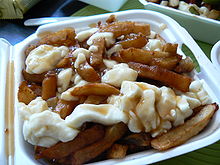 Québécois Poutine: Fries, Curds, and Gravy.
Québécois Poutine: Fries, Curds, and Gravy.
Canadian cuisine varies widely depending on the regions of the nation. The former Canadian prime minister Joe Clark has been paraphrased to have noted: "Canada has a cuisine of cuisines. Not a stew pot, but a smorgasbord."[46] There are considerable overlaps between Canadian food and the rest of the cuisine in North America, many unique dishes (or versions of certain dishes) are found and available only in the country. Common contenders as the Canadian national food include Poutine[47][48][49] and Butter tarts.[50][51] A noteworthy fact is that Canada is the world's largest producer of Maple syrup.[52]
The three earliest cuisines of Canada have First Nations, English, and French roots, with the traditional cuisine of English Canada closely related to British and American cuisine, while the traditional cuisine of French Canada has evolved from French cuisine and the winter provisions of fur traders.[53] With subsequent waves of immigration in the 18th and 19th century from Central, Southern, and Eastern Europe, and also from China, the regional cuisines were subsequently augmented.[53]
Outside views
In 1984, Baron Moran, the British High Commissioner to Canada, stated that, in his opinion, Canadians have limited talents and are "deeply unimpressive." Said Moran, "Anyone who is even moderately good at what they do — in literature, the theater, skiing of whatever — tends to become a national figure. And anyone who stands out at all from the crowd tends to be praised to the skies and given the Order of Canada at once."[54]
A 2007 poll ranked Canada as the country with the most positive influence in the world. 28,000 people in 27 countries were asked to rate 12 countries as either having a positive or negative worldwide influence. Canada’s overall influence rating topped the list with 54 per cent of respondents rating it mostly positive and only 14 per cent mostly negative.[55]
The United States is home to a number of perceptions about Canadian culture, due to the countries' partially-shared heritage and the relatively large number of cultural features common to both the US and Canada. Many in the United States believe that the typical Canadian is more polite than his or her American counterpart.[56] Canada and the United States are often inevitably compared as sibling countries, and the perceptions that arise from this oft-held contrast have gone to shape the advertised worldwide identities of both nations: the United States is seen as the rebellious child of the British Crown, forged in the fires of violent revolution; Canada is the more calm offspring of the United Kingdom known for a more relaxed national demeanor.[56]
See also
References
- ^ a b Kalman, Bobbie (2010). Canada: The Culture. Crabtree Pub. pp. 4–7. ISBN 9780778792840. http://books.google.com/?id=gPEItATPByoC&pg=PA4&dq=Canada+and+its+people#v=onepage&q&f=true. Retrieved 2010-12-16.
- ^ edited by Kenneth G. Pryke, Walter C. Soderlund (2000). Profiles of Canada. Boulder, Colo. NetLibrary. ISBN 058527925X.
- ^ National Film Board of Canada (2005). "Mandate of the National Film Board". Archived from the original on 2006-04-21. http://web.archive.org/web/20060421170854/http://www.nfb.ca/atonf/organisation.php?v=h&lg=en. Retrieved 2006-03-15.
- ^ "Canada in the Making: Pioneers and Immigrants". The History Channel. 2005-08-25. http://www.canadiana.org/citm/themes/pioneers/pioneers7_e.html. Retrieved 2006-11-30.
- ^ A Dialogue on Foreign Policy. Department of Foreign Affairs and International Trade. 2003-01. pp. 15–16. http://www.foreign-policy-dialogue.ca/pdf/DialogueEng.pdf. Retrieved 2006-11-30.
- ^ "Quebec". The Columbia Electronic Encyclopedia, Sixth Edition. Columbia University Press. 2003. http://www.answers.com/topic/quebec-city-quebec. Retrieved 2006-11-30.
- ^ "American Civil war". The Canadian Encyclopedia. Historica Founcation. 2003. http://www.thecanadianencyclopedia.com/index.cfm?PgNm=TCE&Params=A1ARTA0000174. Retrieved 2006-11-30.
- ^ Speakers of the Canadian House of Commons. Parliament of Canada. 2001. pp. 8–9.
- ^ "Multiculturalism in Canada". Mount Allison University. 2002-01-26. http://www.mta.ca/faculty/arts/canadian_studies/english/about/multi/index.htm#policy. Retrieved 2006-11-30.
- ^ Marcia Wallace (1999). Planning Amidst Diversity: The Challenges of Multiculturalism in Urban and Suburban Greater Toronto. University of Waterloo. http://ceris.metropolis.net/Virtual%20Library/other/wallace1/chapt5.html. Retrieved 2006-11-30.
- ^ "A Newcomer’s Introduction to Canada". Citizenship and Immigration Canada. 2006-07-01. Archived from the original on 2006-11-29. http://web.archive.org/web/20061129043445/http://www.cic.gc.ca/english/newcomer/guide/section-07.html#6. Retrieved 2006-12-06.
- ^ B.A. Robinson (2005-11-20). "Same-Sex Marriages (SSM) in Canada". Ontario Consultants on Religious Tolerance. http://www.religioustolerance.org/hom_marb0.htm. Retrieved 2006-11-30.
- ^ a b Woodcock, part I
- ^ Wolf, chapter 6
- ^ Department of Canadian Heritage[dead link]
- ^ John Ralston Saul, Reflections of a Siames Twin: Canada at the End of the 20th Century, Toronto: Viking Canada, 1997, p. 439
- ^ Philip Resnick, The European Roots of Canadian Identity, Peterborough: Broadview Press Ltd, 2005 p. 63
- ^ Roy McGregor, Canadians: A Portrait of a Country and Its People, Toronto: Viking Canada, 2007
- ^ Saul,Reflections of a Siamese Twin p. 8.
- ^ MacGregor, p.39
- ^ Toronto: McClelland & Stewart, 2007, p. 3, ISBN 978-0-7710-2181-7
- ^ MacGregor, Canadians, at p. 40: "I've often thought myself that Canadians ingeniously use this endless 'search' for identity as a handy excuse to wallow in their own self-righteousness--particularly at those moments when America has put the stuck-up Canadian nose out of joint. It could be construed as a sort of verbal party trick to turn the conversation around to oneself and all the comforting goodness of being Canadian
- ^ "National Horse of Canada Act". Canlii.org. http://www.canlii.org/ca/sta/n-10.7/. Retrieved 2011-02-25.
- ^ "The beaver". Pch.gc.ca. 2008-12-17. http://www.pch.gc.ca/pgm/ceem-cced/symbl/o1-eng.cfm. Retrieved 2011-02-25.
- ^ "The Maple Leaf". Pch.gc.ca. 2008-11-17. http://www.pch.gc.ca/pgm/ceem-cced/symbl/o3-eng.cfm. Retrieved 2011-02-25.
- ^ "Robert Fulford's column about the international success of Canadian literature". Robertfulford.com. 2001-06-06. http://www.robertfulford.com/CanadianNovelists.html. Retrieved 2011-02-25.
- ^ Music in Canada 1600-1800. by Amtmann, Willy. Cambridge, Ont. : Habitex Books, 1975. 320 p.(ISBN 0-88912-020-X)
- ^ La Musique au Québec 1600-1875. by Michelle Pharand. Montreal: Les Éditions de l'Homme (1976) (ISBN 0-7759-0517-8)
- ^ Music in Canada: A Research and Information Guide, Carl Morey. New York: Garland Publishing, 1997. Books.google.ca. http://books.google.ca/books?id=eZQch8ieRtsC&pg=PP1&dq=Music+in+Canada:+A+Research+and+Information+Guide,#v=onepage&q=&f=false. Retrieved 2011-02-25.
- ^ "The history of broadcasting in Canada". The Canadian Communications Foundation. http://www.broadcasting-history.ca/timeline/CCFTimeline.html.
- ^ Profiles of Canada. edited by Kenneth G. Pryke, Walter C. Soderlund. Boulder, Colo. : NetLibrary, 2000.(ISBN 0-585-27925-X)
- ^ "History of Canada in music". Historica Foundation of Canada. http://www.thecanadianencyclopedia.com/index.cfm?PgNm=TCE&Params=U1ARTU0001624.
- ^ Canadian Music: Issues of Hegemony & Identity, eds Beveley Diamond & Robert Witmer. Canadian Scholars Press, 1994.
- ^ Edmonton Fringe sets box-office record[dead link]
- ^ * Charles Foster, Stardust and Shadows: Canadians in Early Hollywood, 2000, page27- 34 ISBN 1-55002-348-9
- ^ NFB official site[dead link]
- ^ "Toronto International Film Festival". Tiff.net. http://www.tiff.net/default.aspx. Retrieved 2011-02-25.
- ^ a b http://business.financialpost.com/2011/05/30/canadas-home-grown-video-game-industry-shines-on-international-stage/
- ^ Scobie, Stephen "Humorous Writing in English". The Canadian Encyclopedia. Retrieved on: April 23, 2010.
- ^ Lacombe, Michelle "Humorous Writing in French". The Canadian Encyclopedia. Retrieved on: April 23, 2010.
- ^ a b "National Sports of Canada Act (1994)". Consolidated Statutes and Regulations. Department of Justice. http://lois.justice.gc.ca/en/N-16.7/251603.html. Retrieved 2006-07-20.
- ^ Canadian Press (2006-06-08). "Survey: Canadian interest in pro football is on the rise". Globe and Mail. http://www.theglobeandmail.com/servlet/story/RTGAM.20060608.wsurvey8/BNStory/Sports/home. Retrieved 2006-06-08.
- ^ William Houston (2006-12-20). "Grey Cup moves to TSN in new deal". The Globe And Mail. Archived from the original on 2007-09-30. http://web.archive.org/web/20070930060621/http://www.theglobeandmail.com/servlet/story/RTGAM.20061220.wsptcfl20/GSStory/GlobeSportsFootball/GlobeSports/?query=. Retrieved 2006-12-23.
- ^ "Canadian Cricket Heritage Fund" (PDF). http://www.canadiancricket.org/images/CCA%20Heritage%20Fund.pdf. Retrieved 2011-02-25.
- ^ "Support for Cricket Across the Pond" (PDF). http://www.toronto.ca/legdocs/mmis/2008/cc/bgrd/mm21.6.pdf. Retrieved 2011-02-25.
- ^ Pandi, George (2008-04-05), "Let's eat Canadian, but is there really a national dish?", The Gazette (Montreal), http://www.canada.com/montrealgazette/columnists/story.html?id=6ad83058-3f7b-4403-8aa8-dce47b16884e Also published as "Canadian cuisine a smorgasbord of regional flavours"
- ^ Trillin, Calvin (2009-23-11), "Canadian Journal, "Funny Food,"", The New Yorker: 68–70
- ^ Wong, Grace (2010-10-02), Canada's national dish: 740 calories -- and worth every bite?, CNN, http://articles.cnn.com/2010-10-02/world/canada.poutine_1_dish-cheese-curds-foie?_s=PM:WORLD
- ^ Sufrin, Jon (2010-04-22), "Is poutine Canada’s national food? Two arguments for, two against", Toronto Life, http://www.torontolife.com/daily/daily-dish/aprons-icons/2010/04/22/is-poutine-canadas-national-food-two-arguments-for-two-against/
- ^ Baird, Elizabeth (2009-06-30), "Does Canada Have a National Dish?", Canadian Living, http://www.canadianliving.com/blogs/food/2009/06/30/does-canada-have-a-national-dish/
- ^ DeMONTIS, RITA (2010-06-21), "Canadians butter up to this tart", Toronto Sun, http://www.torontosun.com/life/eat/2010/03/04/13112421.html
- ^ "Maple Syrup." Ontario Ministry of Agriculture, Food and Rural Affairs. Accessed July 2011.
- ^ a b Linda Civitello (29 March 2011). Cuisine and Culture: A History of Food and People. John Wiley & Sons. pp. 401–402. ISBN 978-0-470-40371-6. http://books.google.com/books?id=CwRE0HIIyWkC&pg=PA401. Retrieved 6 November 2011.
- ^ (Associated Press), "Letters reveal candid views of UK diplomats", WTOP, October 18, 2009.
- ^ "Canada - A Good Influence on the World". Canadavisa.com. 2007-03-07. http://www.canadavisa.com/canada-a-good-influence-on-the-world.html. Retrieved 2010-06-30.
- ^ a b "As I Please - The Great Myth of Canada". Seacoastnh.com. http://seacoastnh.com/arts/please031404.html. Retrieved 2011-06-10.
Further reading
Main article: Bibliography of Canada- Beaty, Bart; Derek Briton (2010), How Canadians Communicate III: Contexts of Canadian Popular Culture, AU Press, ISBN 9781897425596, http://books.google.ca/books?id=jjqitK-cRb4C&lpg=PA183&dq=Contemporary%20Canadian%20Art&pg=PP1#v=onepage&q&f=true
- Cameron, Elspeth (1997), Canadian culture, Canadian Scholars' Press, ISBN 1551300907, http://books.google.ca/books?id=nlaMbSkgwL4C&lpg=PP1&dq=Canadian%20Culture&pg=PP1#v=onepage&q&f=true
- Carment, David; David Jay Bercuson (2008), The world in Canada: diaspora, demography, and domestic politics, McGill-Queen's Univ. Press, ISBN 9780773532960, http://books.google.ca/books?id=OZJFUAPGh_0C&lpg=PA18&dq=Canada%20in%20World%20Affairs&pg=PP1#v=onepage&q&f=true
- Clément, Dominique (2009), Canada's Rights Revolution: Social Movements and Social Change, 1937-82, Univ of British Columbia Prres, ISBN 9780774814805, http://books.google.ca/books?id=-kgS9cr2JYUC&lpg=PA34&dq=Culture%20of%20Canada&pg=PP1#v=onepage&q&f=true
- Colombo, John Robert (1 June 2001). 1000 questions about Canada: places, people, things, and ideas. Dundurn Press Ltd.. ISBN 9780888822321. http://books.google.com/books?id=wmRI6_3da2sC&pg=PP1.
- Edwardson, Ryan (2008), Canadian content: culture and the quest for nationhood, University of Toronto Press, ISBN 9780802097590, http://books.google.ca/books?id=IxVuSFLo8fAC&lpg=PP1&dq=Canadian%20content&pg=PP1#v=onepage&q&f=true
- Flaherty, David H; Frank E. Manning (1993), The Beaver bites back?: American popular culture in Canada, : McGill-Queen's University Press, ISBN 0773511199, http://books.google.ca/books?id=5xcRX1wwqy4C&lpg=PP1&dq=Culture%20of%20Canada&pg=PP1#v=onepage&q&f=true
- Greenhill, Pauline; Diane Tye (1997), Undisciplined women: tradition and culture in Canada, McGill-Queen's University Press, ISBN 0773516158, http://books.google.ca/books?id=yGuxrI4lDJoC&lpg=PP1&dq=Culture%20of%20Canada&pg=PP1#v=onepage&q&f=true
- Howells, Coral Ann (2004), Where are the voices coming from?: Canadian culture and the legacies of history, Rodopi, ISBN 904201623X, http://books.google.ca/books?id=609xln7MN4AC&lpg=PP1&dq=Canadian%20Culture&pg=PP1#v=onepage&q&f=true
- Kearney, Mark; Randy Ray (2009), The Big Book of Canadian Trivia, Dundurn Press, ISBN 9781554884179, http://books.google.ca/books?id=RoBytz0-XuQC&lpg=PP1&dq=The%20Big%20Book%20of%20Canadian%20Trivia&pg=PP1#v=onepage&q&f=true
- Kearney, Mark; Randy Ray (1999), The great Canadian book of lists, Hounslow Press, ISBN 0888822138, http://books.google.ca/books?id=eMouyNJYOo8C&lpg=PA3&dq=Greatest%20Canadian&pg=PA3#v=onepage&q&f=true
- Kelley, Ninette; Michael J. Trebilcock (2010), The Making of the Mosaic: A History of Canadian Immigration Policy (2nd ed.), University of Toronto Press, ISBN 9780802095367, http://books.google.ca/books?id=3IHyRvsCiKMC&lpg=PP1&dq=Immigration%20to%20Canada%E2%80%8E&pg=PP1#v=onepage&q&f=true
- Mookerjea, Sourayan; Imre Szeman, Gail Faurschou (2009), Canadian cultural studies: a reader, Duke University Press, ISBN 9780822343981, http://books.google.ca/books?id=r7QRD2j00l8C&lpg=PP1&dq=Canadian%20Culture&pg=PP1#v=onepage&q&f=true
- Podnieks, Andrew (2006), A Canadian Saturday Night: Hockey and the Culture of a Country, Greystone Books, ISBN 9781553652014, http://books.google.ca/books?id=qnVpwcFbNWQC&lpg=PP1&dq=Canadian%20Culture&pg=PP1#v=onepage&q&f=true
- David Morton Rayside; Clyde Wilcox (2011). Faith, Politics, and Sexual Diversity in Canada and the United States. UBC Press. ISBN 978-0-7748-2009-7. http://books.google.com/books?id=7D9n76J5wi4C&pg=PP1.
- Roberts, Lance W (2005), Recent social trends in Canada, 1960-2000, McGill-Queen's University Press, ISBN 0773529551, http://books.google.ca/books?id=qnPOqwsR5UsC&lpg=PA281&dq=minimum%20wages%20in%20Canada&pg=PP1#v=onepage&q&f=true
- Wiseman, Nelson (2007), In search of Canadian political culture, niv of British Columbia Prres, ISBN 9780774813884, http://books.google.ca/books?id=TD5bmHBbDFIC&lpg=PP1&dq=Canadian%20Culture&pg=PP1#v=onepage&q&f=true
External links
- Canadian Heritage
- Culture.CA: Canadian cultural portal online
- Ontario Ministry of Culture
- CRTC Canadian Content
- Podcasts database on Culture.ca
- Peel's Prairie Provinces: A full-text, searchable database of digitized prairie Canadiana, including newspapers and other Western Canadian publications
Categories:- Canadian culture
Wikimedia Foundation. 2010.


